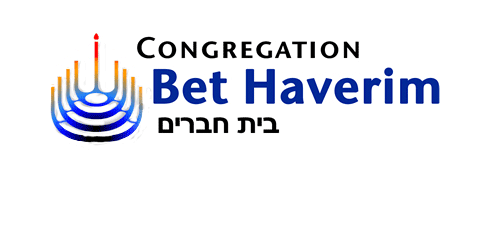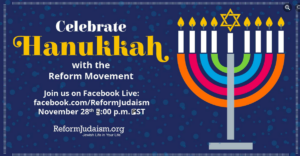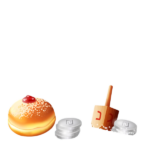
Stories, blessings and recipes to illuminate your holiday from Thursday, November 28 to December 6, 2021. Celebrate With Your CBH Haverim!
To navigate this page, here are some Quick Clicks:
- Services — directly below here
- The Candles — lighting and blessings
- How to play Dreidel and songs to sing
- How to make the perfect latkes and other food ideas
- More Hanukkah resources
In anticipation of Hannukah, our Partnership Committee will be hosting our annual Hannukah Hike on Sunday, November 28th.
Join us for a very special FB Live gathering on the first night of Hannukah, Sunday, November 28th at 5 p.m. (Pacific time) with your Reform Jewish family across the country! You will be able to access the celebration at facebook.com/ReformJudaism. The Hannukah gathering will be just about 30 minutes long and is full of lots of light, sweetness, and some beautiful messages from really outstanding Reform Jews from around our community.
 When this special presentation is over we will gather over zoom at 5:30 pm (at our regular shabbat zoom link) to kindle the Hannukah lights together and to sing some of our own Hannukah songs.
When this special presentation is over we will gather over zoom at 5:30 pm (at our regular shabbat zoom link) to kindle the Hannukah lights together and to sing some of our own Hannukah songs.
All are invited to join us for our annual Family Hannukah Shabbat service on Friday, December 3rd at 6 pm. We will be welcoming the participation of our enthusiastic 5th grade/Gimmel Hebrew class. You can join the service by zoom or in person.
Enjoy a wonderful Hannukah Film Festival with a different movie each night! Here is the link to the website with all the information: www.HanukkahFilmFestival.com. Every ticket purchased with our promo code will go towards supporting CBH. We receive 50% of the proceeds if you use HAVER when you purchase. Hanukkah Film Fest 2021 Flyer v1
Our special promo code is HAVER.
THE HANUKKAH STORY
Although according to Jewish custom Hanukkah is considered a “minor” Jewish festival, today it ranks—along with Passover and Purim—as one of the most beloved Jewish holidays, full of light and joy and family celebration.
Unlike many Jewish holidays, Hanukkah (also known as the Festival of Lights) is not mentioned in the Bible. The historical events upon which the celebration is based are recorded in Maccabees I and II, two books contained within a later collection of writings known as the Apocrypha.
In the year 168 B.C.E., the Syrian king Antiochus Epiphanes sent his soldiers to Jerusalem. The Syrians desecrated the Temple, the holiest place for Jews at that time. Antiochus also abolished Judaism, outlawing the observance of Shabbat and the Festivals, as well as circumcision. Altars and idols were set up for the worship of Greek gods, and he offered Jews two options: conversion or death.
On the 25th day of the Hebrew month of Kislev in 168 B.C.E., the Temple was renamed for the Greek god Zeus. A Jewish resistance movement – led by a priestly family known as the Hasmoneans, or Maccabees – developed against the cruelty of Antiochus. The head of the family was Mattathias, an elderly man. His son, Judah, became the chief strategist and military leader of the resistance. Though outnumbered, Judah Maccabee and his fighters miraculously won two major battles, routing the Syrians decisively.
Although historians debate the causes and outcomes of the war in which Judah Maccabee and his followers defeated the Syrian armies of Antiochus, there is no doubt that Hanukkah evokes stirring images of Jewish valor against overwhelming odds. Other themes of the holiday include the refusal to submit to the religious demands of an empire practicing idolatry, the struggle against total assimilation into Greek culture and loss of Jewish identity, and the fight for Jewish political autonomy and self-determination.
Hanukkah, which means “dedication,” is the festival that commemorates the purification and rededication of the Temple following the Greek occupation of that holy place. Today, the holiday reminds Jews to rededicate themselves to keeping alive the flame of Jewish religion, culture, and peoplehood so that it may be passed on to the next generation.
Originally, the eight-day holiday was intended to parallel the eight-day festival of Sukkot. The Books of the Maccabees made no mention of the legend concerning a small jar of oil that unexpectedly lasted for eight days. Only centuries after the Maccabees’ defeat of the Syrians did the story of the jar of oil – which has come to be associated with Hanukkah – appear in the Talmud.
According to the legend, when the Maccabees entered the Temple and began to reclaim it from the Greeks, they immediately relit the ner tamid (eternal light), which burned constantly in the Temple and has a parallel in our synagogues to this day. In the Temple, they found a single jar of oil, which was sufficient for only one day. The messenger who was sent to secure additional oil took eight days to complete his mission, and miraculously, the single jar of oil continued to burn until his return. The rabbis of the Talmud attributed the eight days of Hanukkah to the miracle of this single jar of oil. (from reformjudaism.org)
Candles are added to the hanukkiyah (menorah) from right to left but are kindled from left to right. The newest candle is lit first. On the Shabbat of Hanukkah, kindle the Hanukkah lights first and then the Shabbat candles.
Light the shamash (the helper candle) first, using it to kindle the rest of the Hanukkah lights. As you do, say or sing:
 Baruch atah, Adonai Eloheinu, Melech haolam, asher kid’shanu b’mitzvotav v’tsivanu l’hadlik ner shel Hanukkah.
Baruch atah, Adonai Eloheinu, Melech haolam, asher kid’shanu b’mitzvotav v’tsivanu l’hadlik ner shel Hanukkah.
Blessed are You, Adonai our God, Sovereign of all, who hallows us with mitzvot, commanding us to kindle the Hanukkah lights.
 Baruch atah, Adonai Eloheinu, Melech haolam, she-asah nisim laavoteinu v’imoteinu bayamim hahaeim baz’man hazeh.
Baruch atah, Adonai Eloheinu, Melech haolam, she-asah nisim laavoteinu v’imoteinu bayamim hahaeim baz’man hazeh.
Blessed are You, Adonai our God, Sovereign of all, who performed wonderous deeds for our ancestors in days of old at this season.
For first night only:
 Baruch atah, Adonai Eloheinu, Melech haolam, shehecheyanu v’kiy’manu v’higiyanu laz’man hazeh.
Baruch atah, Adonai Eloheinu, Melech haolam, shehecheyanu v’kiy’manu v’higiyanu laz’man hazeh.
Blessed are You, Adonai our God, Sovereign of all, who has kept us alive, sustained us, and brought us to this season.
Hanerot Halalu
We kindle these lights because of the wondrous deliverance You performed for our ancestors.
During these eight days of Hanukkah, these lights are sacred; we are not to use them but only to behold them, so that their glow may rouse us to give thanks for Your wondrous acts of deliverance.
Build an Ice Menorah, or “Kerachanukiyah“!
HOW TO PLAY DREIDEL GAMES PLUS SONGS TO SING
Virtual dreidel if you don’t have one handy!
A video about how to make marshmallow dreidels.
Rules and more on the Hanukkah webpage at MyJewishLearning.com
Songs, lyrics — everything you need for a musical holiday at MyJewishLearning.com
A doughnut for each night of Hanukkah, recommended by Rabbi Greg: “written by my colleague Rabbi Debbie Prinz and also featuring my friend, Cantor Evan Kent.”
EVERYONE LOVES LATKES — recipe from Torie Avey
Ingredients
- 2 1/2 lbs potatoes (I prefer Yukon Gold)
- 1 large onion, shredded
- 3/4 cup matzo meal or bread crumbs
- 2 large eggs, beaten
- 1 tbsp potato starch, or more if needed
- 1 1/4 tsp salt, or more to taste
- 1/2 tsp pepper
- Avocado, peanut or grapeseed oil for frying (about 1 1/2 cups – choose an oil with a high smoke point)
- 1/4 cup schmaltz (optional)
Recipe Notes
You will also need: hand grater or food processor with shredding disc attachment with choice of large holes or fine holes, clean tea towel or layers of cheesecloth, skillet or electric skillet for frying, colander, large mixing bowl, medium bowl, metal spatula, wire cooling rack
Note: I add dry potato starch to the potato mix, which helps these latkes to hold together and creates a lighter, fluffier texture. The latkes can be made without it, but they may not hold together as well when frying.
If you’re serving latkes with dairy sour cream and want to keep things kosher, do not add the optional schmaltz to the frying oil, or choose a non-dairy sour cream.
Instructions
-
Before you begin making the latkes, place your wire cooling rack close to the area where you will be frying the latkes. Place a layer of paper towels below the cooling rack to catch excess oil.
-
Cut the potatoes into large chunks and shred using a hand grater or food processor shredding attachment with large holes (large shreds). I really recommend using the food processor, it saves a ton of time and will help you avoid tears when grating the onion.
-
Place grated potato into a bowl and immediately cover with cold water.
-
Meanwhile, grate the onion using the grater or food processor attachment with fine holes (small shreds).
-
Drain the potato shreds in a colander. Rinse and dry the bowl used to soak the shreds and set aside.
-
Place drained potato shreds and grated onion in the center of a clean tea towel or multiple layers of cheesecloth.
-
Wrap the shreds up in the cloth, twisting the cloth to secure the bundle, and squeeze firmly to remove excess liquid from the shreds.
-
Pour potato and onion into the clean dry bowl. Stir the shreds with a fork to make sure the grated onion is evenly mixed throughout the potato shreds.
-
In a skillet, add oil to reach a depth of 1/8 inch. If using schmaltz, add 1/4 cup to the oil. The schmaltz will add more savory flavor to the latkes. Heat slowly over medium to about 365 degrees F.
-
While oil is heating, use the fork to stir the matzo meal, beaten eggs, potato starch, salt and pepper into the potato and onion shreds. Add salt and pepper to taste; I add about 1 1/4 tsp salt and 1/2 tsp pepper. You can sprinkle on more salt to taste after cooking, if desired. Take care to make sure the egg and seasonings are fully mixed throughout the potato shreds.
-
Scoop up 3 tbsp of the potato mixture and shape into a tightly compacted disk.
-
Place the disk carefully into the hot oil. Latkes can break apart at this point, they’re very delicate. If you can get them into the hot oil in one piece, chances are they will stick together – frying them is like the “glue” that holds them together. It takes a gentle touch, and it may take you some practice to get the “feel” for it.
-
The oil should sizzle, but not pop when the latke hits it; if the oil jumps wildly or smokes, it is too hot. If it only bubbles weakly, the oil is not hot enough. Use the first latke to test the oil temperature, and don’t fry a whole batch until the temperature is right.
-
Note: If your latkes aren’t holding together, stir more potato starch into the mixture, 2 teaspoons at a time, until the batter “holds”. You can also add another egg to the mixture and more matzo meal, if needed.
-
Continue shaping the latkes in this way, using 3 tablespoons of potato mixture for each latke. Fry in batches of 4-5 latkes at a time (no more than that – don’t crowd the pan) for 2-3 minutes per side until brown and crispy.
-
Remove the latkes from the pan using a metal spatula and place them on the wire cooling rack to drain.
-
I recommend serving latkes fresh within 10 minutes of frying them, if your cooking schedule permits. If you need to make them ahead, fry them 2 hours or less before serving. You can also freeze them if you’re not serving them right away.
-
To Reheat Latkes: Place them on an ungreased, unlined cookie sheet. To reheat from room temperature, place in a 375 degree oven for about 10 minutes (7 if using a convection oven), until heated through, just prior to serving. From frozen, it can take 15-25 minutes to reheat. Sprinkle with more salt, if desired, and serve latkes with applesauce and/or sour cream (or dairy free sour cream).
If you want to read more about the holiday and explore other ideas then we suggest the Union of Reform Judaism webpage.


